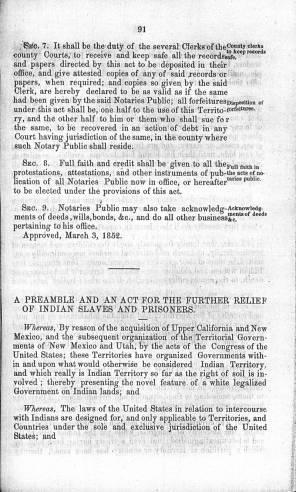5.4 a-b Indentures of two Native American children to Latter-day Saint families
Two Native American children are indentured to Latter-day Saint families, 1853 and 1859
Documents Introduction
The documents in this section represent examples of surviving Native American indentures which were registered with county probate judges or selectmen as required by An Act for the Further Relief of Indian Slaves and Prisoners. The Thomas Benson indenture of a three-year-old girl named Sarah pretends that she was capable of “voluntarily” entering into such an agreement. In contrast, the John Beal indenture of a ten-year-old boy named Samuel is written only as a contract between Beal and the Sanpete County selectmen who witnessed the arrangement. It does not indicate consent on the part of Samuel or include him as a consenting party in the agreement. Both indentures are written to fulfill the requirements of the law and both are centered on notions of apprenticeship in which the person indentured would in theory learn a marketable trade. Both include education requirements as well as establish expectations for treatment of the person being indentured. Both include expectations for what the master must provide the apprentice at the end of the term of service.
There was no mechanism in place to ensure that the terms of the indenture were met. In these two instances, what is missing is Sarah and Samuel’s perspectives on their experiences as indentures in Latter-day Saint families. No matter how they arrived among the Latter-day Saints, their journey began with being removed from their biological families and from Native American culture. The indentures thus represent displacement for Sarah and Samuel. They were displaced from home and family with no effort at reunification built into the law. An Act for the Relief of Indian Slaves and Prisoners was meant to fulfill humanitarian objectives and defend Indigenous children from enslavement or death. Even so, unstated but implied objectives were religious and cultural assimilation. In practice, Samuel and Sarah’s labor belonged to their white masters for the duration of their indentures.


